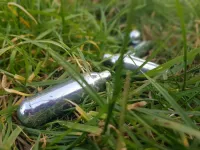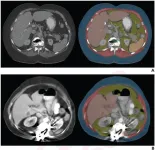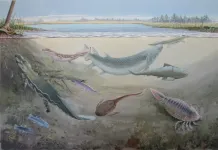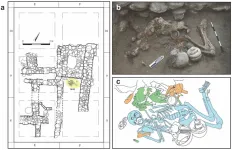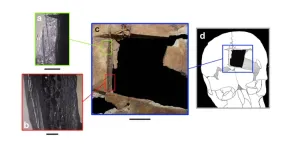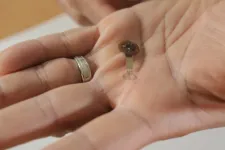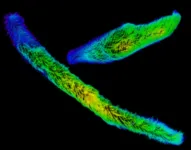(Press-News.org) Imperial experts are calling for more to be done to limit the potentially harmful impact of toxic tyre particles on health and the environment.
The researchers, from Imperial College London’s Transition to Zero Pollution initiative, warn that even though electric vehicles remove the problem of fuel emissions, we will continue to have a problem with particulate matter because of tyre wear.
Six million tonnes of tyre wear particles are released globally each year, and in London alone, 2.6 million vehicles emit around nine thousand tonnes of tyre wear particles annually.
Despite this, research on the environmental and health impacts of tyre wear has been neglected in comparison to the research and innovations dedicated to tackling fuel emissions. The Imperial researchers say that the effect of new technologies on the generation and impact of tyre wear should be a priority.
In a new briefing paper, a multidisciplinary group of Imperial experts including engineers, ecologists, medics, and air quality analysts have called for as much investment into tyre wear research as there is for reducing fuel emissions – and for understanding their interactions.
Lead author Dr Zhengchu Tan, of Imperial’s Department of Mechanical Engineering, said: “Tyre wear particles pollute the environment, the air we breathe, the water run-off from roads and has compounding effects on waterways and agriculture. Even if all our vehicles eventually become powered by electricity instead of fossil fuels, we will still have harmful pollution from vehicles because of tyre wear.
“We urge policymakers and scientists to embark on ambitious research into tyre wear pollution to fully understand and reduce their impacts on biodiversity and health, as well as research to reduce the generation of these particles.”
Transition to Zero Pollution is an Imperial College London initiative which aims to build new partnerships between research, industry, and government to help realise a sustainable zero pollution future.
Professor Mary Ryan, Vice Provost (Research and Enterprise) at Imperial College London, and a co-author on the briefing paper, said: “Safeguarding our planet and the health of future generations requires us to look not just at a problem from a single perspective, but to take a systems level approach. That’s why we need to look beyond just carbon and to consider human-made pollution in all its forms.
“Electric vehicles are a crucial step forward to decarbonise transport, but we need to look at the big picture too. Some are concerned that electric vehicles tend to be heavier, which might increase tyre wear. This is exactly why Imperial College London is driving a holistic, joined-up approach to sustainability challenges.
“We will continue to leverage the full strength of our research and influence to find meaningful solutions and help realise a sustainable, zero pollution future.”
In the briefing paper, the researchers discuss how tyre wear leads to these particles, where the particles end up, their potential effects on people and planet, and why we must act now.
Tyre wear particles
As tyres break down they release a range of particles, from visible pieces of tyre rubber to nanoparticles. Large particles are carried from the road by rain into rivers, where they may leach toxic chemicals into the environment, whilst smaller particles become airborne and breathed in. They are small enough to reach into the deep lung.
These particles may contain a range of toxic chemicals including polyaromatic hydrocarbons, benzothiazoles, isoprene, and heavy metals like zinc and lead.
Environmental effects
Particulate matter from tyre wear is a significant source of ‘microplastics’ in rivers and oceans, and tyre wear in cities could pose up to a four-fold greater risk to the environment than other microplastics.
While existing technological interventions, such as filters, and environmental policies could help to control our ecological footprint, there are huge gaps in our knowledge, understanding, and ability to forecast the impacts of tyre wear pollution.
Co-author Dr Will Pearse, from Imperial’s Department of Life Sciences, said: “Tyre waste does not naturally degrade and instead builds up in the environment, and may interact with other pollutants as well as biological organisms. Our gaps in understanding make further research and development of new solutions vital so we can limit all types of vehicular pollution.”
Health effects
The impact of tyre wear particles on human health is an increasing cause for concern, and the full long-term effects on our health urgently require more research.
There is emerging evidence that tyre wear particles and other particulate matter may contribute to a range of negative health impacts including heart, lung, developmental, reproductive, and cancer outcomes.
Co-author Professor Terry Tetley of Imperial’s National Heart and Lung Institute said: “We are growing increasingly concerned by the impact of tyre wear on human health. As some of these particles are so small they can be carried in the air, it’s possible that simply walking on the pavement could expose us to this type of pollution. It is essential that we better understand the effect of these particles on our health.”
Shifting gear
The researchers argue that reducing tyre pollution should be seen as a critical part of making transport cleaner and more sustainable, alongside reductions in CO2 and other exhaust emissions. In tackling the climate crisis, we should design better systems and technologies to protect the environment; and research funding, government policy and regulatory frameworks should reflect this.
The report authors call for policymakers and scientists to investigate the complex problems related to tyre-wear pollution, from the basics of wear-particle production, to understanding how these particles affect the health of people and the planet. Potential innovation solutions include particle capture technologies, new advanced materials, and disruptive business models that encourage different transport choices. These need to be coupled to clear policy and regulation and to a broader discussion around urban transport systems.
The research efforts, they say, should include the following:
Establishing standardised ways of measuring environmental tyre wear levels and their toxicity.
Reducing harm to land and water species and in humans by tightening limits on the use of harmful components in tyre materials.
Launching new trials to better understand the short and long-term effects of different sized particles on the environment and human health.
Efforts to better understand underlying wear mechanisms and to propose wear mitigation strategies such as reducing vehicle weight, using advanced driving techniques, and ensuring tyre materials pass wear resistance regulations.
ENDS
For more information, please contact:
Caroline Brogan
Media Manager, Imperial College London
caroline.brogan@imperial.ac.uk
+44(0)20 7594 3415
Out of hours press officer mobile: +44 (0)7803 886248
Notes to editors:
To download the embargoed briefing paper see: https://imperialcollegelondon.box.com/s/xep6roua722khctt1q7uhwyez01pfd6b
This press release uses a labelling system developed by the Academy of Medical Sciences to improve the communication of evidence. For more information, please see: http://www.sciencemediacentre.org/wp-content/uploads/2018/01/AMS-press-release-labelling-system-GUIDANCE.pdf
About Imperial College London
Imperial College London is a global top ten university with a world-class reputation. The College's 22,000 students and 8,000 staff are working to solve the biggest challenges in science, medicine, engineering and business.
The Research Excellence Framework (REF) 2021 found that it has a greater proportion of world-leading research than any other UK university, it was named University of the Year 2022 according to The Times and Sunday Times Good University Guide, University of the Year for Student Experience 2022 by the Good University Guide, and awarded a Queen’s Anniversary Prize for its COVID-19 response.
https://www.imperial.ac.uk/
END
Prioritise tackling toxic emissions from tyres, urge Imperial experts
2023-02-23
ELSE PRESS RELEASES FROM THIS DATE:
Surge in nitrous oxide abuse: New guidelines to help clinicians recognise cases and prevent spinal cord damage
2023-02-23
Recommendations from research published today on the diagnosis and treatment of spinal cord damage caused by nitrous oxide abuse have been simultaneously adopted as official clinical practice guidelines by the Association of British Neurologists. The unprecedented speed in translating research into practice is necessary as medical cases of nitrous oxide abuse surge in parallel with increased use of what is now the second most popular recreational drug among young people in the UK.
Recreational use of nitrous oxide (N2O - also known as laughing gas) ...
Technical adequacy of artificial intelligence body composition assessed in external CT
2023-02-23
Leesburg, VA, February 23, 2023—According to an accepted manuscript published in ARRS’ American Journal of Roentgenology (AJR), certain reasons for AI tool failure relating to technical factors may be largely preventable through proper acquisition and reconstruction protocols.
“The automated AI body composition tools had high technical adequacy rates in a heterogeneous sample of external CT examinations, supporting the tools’ generalizability and potential for broad use,” concluded head researcher B. Dustin Pooler, MD, from the University of ...
New predatory fish species which lived about 360 million years ago may have grown to over 2.5m long, according to analysis of South African fossils
2023-02-22
New predatory fish species which lived about 360 million years ago may have grown to over 2.5m long, according to analysis of South African fossils
###
Article URL: https://journals.plos.org/plosone/article?id=10.1371/journal.pone.0281333
Article Title: A high latitude Gondwanan species of the Late Devonian tristichopterid Hyneria (Osteichthyes: Sarcopterygii)
Author Countries: South Africa, Sweden
Funding: PEA: Wallenberg Scholarship (not numbered), from the Knut & Alice Wallenberg Foundation. https://kaw.wallenberg.org PEA: ERC Advanced ...
Influence of US weather conditions on tornado trends since 1980 explored by new model
2023-02-22
Influence of US weather conditions on tornado trends since 1980 explored by new model
###
Article URL: https://journals.plos.org/plosone/article?id=10.1371/journal.pone.0281312
Article Title: Long term temporal trends in synoptic-scale weather conditions favoring significant tornado occurrence over the central United States
Author Countries: USA
Funding: The authors received no specific funding for this work. END ...
Cash transfers in LMICs may help alleviate depression and anxiety symptoms - especially if such transfers are unconditional
2023-02-22
Cash transfers in LMICs may help alleviate depression and anxiety symptoms - especially if such transfers are unconditional
###
Article URL: https://journals.plos.org/plosone/article?id=10.1371/journal.pone.0281283
Article Title: Do cash transfers alleviate common mental disorders in low- and middle-income countries? A systematic review and meta-analysis
Author Countries: UK, Germany
Funding: JS was supported by the Joachim Herz Foundation (https://www.joachim-herz-stiftung.de/en/). AR received funding from the Wellcome Trust (220206/Z/20/Z, ...
Two high status brothers had access to “brain surgery” in Bronze Age Israel
2023-02-22
Two high status brothers buried in a Bronze Age tomb in Israel were severely ill but apparently had access to rare treatments including trephination, according to a study published February 22, 2023 in the open-access journal PLOS ONE by Rachel Kalisher of Brown University, Rhode Island, and colleagues.
In this study, authors examined the remains of two individuals buried in a tomb beneath an elite residence in the archaeological site of Tel Megiddo in Israel. The tomb dates to the Late Bronze Age (around 1550-1450 BC), and DNA testing suggests the buried individuals are brothers. Both skeletons show evidence of disease, providing an opportunity ...
Archaeologists uncover early evidence of brain surgery in Ancient Near East
2023-02-22
PROVIDENCE, R.I. [Brown University] — Archaeologists know that people have practiced cranial trephination, a medical procedure that involves cutting a hole in the skull, for thousands of years. They’ve turned up evidence that ancient civilizations across the globe, from South America to Africa and beyond, performed the surgery.
Now, thanks to a recent excavation at the ancient city of Megiddo, Israel, there’s new evidence that one particular type of trephination dates back to at least the late Bronze Age.
Rachel Kalisher, a Ph.D. candidate at Brown University’s Joukowsky ...
Keeping babies alive will lower population growth – new research
2023-02-22
Keeping babies alive will lower population growth – new research
New research showing high infant mortality rates are contributing to an incessant rise of the global human population supports arguments for greater access to contraception and family planning in low- and middle-income nations.
In an article published in PLOS ONE, research led by Professor Corey Bradshaw, Matthew Flinders Professor of Global Ecology from Flinders University and Peter Le Souëf, Professor of Paediatrics from The University of Western Australia has found that with higher baby death rates and larger household sizes (as an indicator of population density), ...
First transient electronic bandage speeds healing by 30%
2023-02-22
Wireless, battery-free bandage delivers electrical signals to help wounds heal
Bandage monitors healing, streaming data in real time to a smartphone or tablet
After healing is complete, bandage and electronics harmlessly absorb into the body
EVANSTON, Ill. — Northwestern University researchers have developed a first-of-its-kind small, flexible, stretchable bandage that accelerates healing by delivering electrotherapy directly to the wound site.
In an animal study, the new bandage healed ...
Giant proteins in a giant cell: Molecular basis behind fastest biological movement of single-celled eukaryotes
2023-02-22
In his famous letter to the Royal Society dated Oct. 9, 1676, Antonie van Leeuwenhoek described a single-celled eukaryote (Vorticella) and its fascinating ultrafast cell contraction as the first set of discoveries. This kind of ultrafast cell contraction triggered by a Ca2+-dependent mechanism is distinct from the adenosine triphosphate (ATP)-dependent mechanisms found in actin-myosin and dynein/kinesin-tubulin systems.
Spirostomum, is a genus of millimeter-scale single-celled protists that are known for their incredibly rapid movement like Vorticella. They are capable ...
